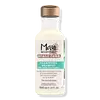What's inside
What's inside
 Key Ingredients
Key Ingredients

 Benefits
Benefits

 Concerns
Concerns

 Ingredients Side-by-side
Ingredients Side-by-side

Aloe Barbadensis Leaf Juice
Skin ConditioningWater
Skin ConditioningSodium C14-16 Olefin Sulfonate
CleansingCocamidopropyl Betaine
CleansingCoco-Glucoside
CleansingCitric Acid
BufferingGlycol Distearate
EmollientVinegar
Tocopheryl Acetate
AntioxidantCocos Nucifera Water
MaskingNigella Sativa Seed Oil
EmollientOpuntia Ficus-Indica Seed Oil
EmollientAdansonia Digitata Seed Oil
EmollientCocos Nucifera Seed Butter
Skin ConditioningButyrospermum Parkii Butter
Skin ConditioningCalophyllum Inophyllum Seed Oil
AntimicrobialMoringa Oleifera Seed Oil
EmollientTetraselmis Suecica Extract
Skin ConditioningHydroxyphenyl Propamidobenzoic Acid
Skin ConditioningPEG-5 Ethylhexanoate
EmulsifyingTrideceth-9
EmulsifyingMannitol
HumectantPolyquaternium-10
Acrylates Crosspolymer-4
Emulsion StabilisingLaureth-4
EmulsifyingGlycerin
HumectantGuar Hydroxypropyltrimonium Chloride
Skin ConditioningPEG-150 Pentaerythrityl Tetrastearate
EmulsifyingPPG-2 Hydroxyethyl Cocamide
EmulsifyingHexylene Glycol
EmulsifyingSodium Citrate
BufferingSodium Hydroxide
BufferingSodium Benzoate
MaskingParfum
MaskingAloe Barbadensis Leaf Juice, Water, Sodium C14-16 Olefin Sulfonate, Cocamidopropyl Betaine, Coco-Glucoside, Citric Acid, Glycol Distearate, Vinegar, Tocopheryl Acetate, Cocos Nucifera Water, Nigella Sativa Seed Oil, Opuntia Ficus-Indica Seed Oil, Adansonia Digitata Seed Oil, Cocos Nucifera Seed Butter, Butyrospermum Parkii Butter, Calophyllum Inophyllum Seed Oil, Moringa Oleifera Seed Oil, Tetraselmis Suecica Extract, Hydroxyphenyl Propamidobenzoic Acid, PEG-5 Ethylhexanoate, Trideceth-9, Mannitol, Polyquaternium-10, Acrylates Crosspolymer-4, Laureth-4, Glycerin, Guar Hydroxypropyltrimonium Chloride, PEG-150 Pentaerythrityl Tetrastearate, PPG-2 Hydroxyethyl Cocamide, Hexylene Glycol, Sodium Citrate, Sodium Hydroxide, Sodium Benzoate, Parfum
Water
Skin ConditioningGlycerin
HumectantDisodium Cocoamphodipropionate
CleansingSodium C14-16 Olefin Sulfonate
CleansingCocamidopropyl Betaine
CleansingCitric Acid
BufferingRicinus Communis Seed Oil
MaskingCroton Zambesicus Powder
Glycine Soja Seed Extract
Skin ConditioningCurcumin
AntioxidantDecyl Glucoside
CleansingPanthenol
Skin ConditioningPolyquaternium-7
Polyquaternium-10
Phenoxyethanol
PreservativeEthylhexylglycerin
Skin ConditioningWater, Glycerin, Disodium Cocoamphodipropionate, Sodium C14-16 Olefin Sulfonate, Cocamidopropyl Betaine, Citric Acid, Ricinus Communis Seed Oil, Croton Zambesicus Powder, Glycine Soja Seed Extract, Curcumin, Decyl Glucoside, Panthenol, Polyquaternium-7, Polyquaternium-10, Phenoxyethanol, Ethylhexylglycerin
Ingredients Explained
These ingredients are found in both products.
Ingredients higher up in an ingredient list are typically present in a larger amount.
Citric Acid is an alpha hydroxy acid (AHA) naturally found in citrus fruits like oranges, lemons, and limes.
Like other AHAs, citric acid can exfoliate skin by breaking down the bonds that hold dead skin cells together. This helps reveal smoother and brighter skin underneath.
However, this exfoliating effect only happens at high concentrations (20%) which can be hard to find in cosmetic products.
Due to this, citric acid is usually included in small amounts as a pH adjuster. This helps keep products slightly more acidic and compatible with skin's natural pH.
In skincare formulas, citric acid can:
While it can provide some skin benefits, research shows lactic acid and glycolic acid are generally more effective and less irritating exfoliants.
Most citric acid used in skincare today is made by fermenting sugars (usually from molasses). This synthetic version is identical to the natural citrus form but easier to stabilize and use in formulations.
Read more about some other popular AHA's here:
Learn more about Citric AcidCocamidopropyl Betaine is a fatty acid created by mixing similar compounds in coconut oil and dimethylaminopropylamine, a compound with two amino groups.
This ingredient is a surfactant and cleanser. It helps gather the dirt, pollutants, and other impurities in your skin to be washed away. It also helps thicken a product and make the texture more creamy.
Being created from coconut oil means Cocamidopropyl Betaine is hydrating for the skin.
While Cocamidopropyl Betaine was believed to be an allergen, a study from 2012 disproved this. It found two compounds in unpure Cocamidopropyl Betaine to be the irritants: aminoamide and 3-dimethylaminopropylamine. High-grade and pure Cocamidopropyl Betaine did not induce allergic reactions during this study.
Learn more about Cocamidopropyl BetaineGlycerin is already naturally found in your skin. It helps moisturize and protect your skin.
A study from 2016 found glycerin to be more effective as a humectant than AHAs and hyaluronic acid.
As a humectant, it helps the skin stay hydrated by pulling moisture to your skin. The low molecular weight of glycerin allows it to pull moisture into the deeper layers of your skin.
Hydrated skin improves your skin barrier; Your skin barrier helps protect against irritants and bacteria.
Glycerin has also been found to have antimicrobial and antiviral properties. Due to these properties, glycerin is often used in wound and burn treatments.
In cosmetics, glycerin is usually derived from plants such as soybean or palm. However, it can also be sourced from animals, such as tallow or animal fat.
This ingredient is organic, colorless, odorless, and non-toxic.
Glycerin is the name for this ingredient in American English. British English uses Glycerol/Glycerine.
Learn more about GlycerinPolyquaternium-10 is an ammonium salt of hydroxyethylcellulose. It is a white and granular powder used as a film-former and anti-static agent.
This ingredient is commonly found in hair conditioning products. According to a manufacturer, its positive charge makes it great for absorbing hair proteins. The manufacturer also states this ingredient helps with curl retention.
For haircare friends: this ingredient is not a silicone.
Learn more about Polyquaternium-10Sodium C14-16 Olefin Sulfonate is a cleansing agent made from a mixture of long chain sulfonate salts. It can also help produce foam.
This ingredient may be drying. We recommend speaking with a professional if you have concerns.
Water. It's the most common cosmetic ingredient of all. You'll usually see it at the top of ingredient lists, meaning that it makes up the largest part of the product.
So why is it so popular? Water most often acts as a solvent - this means that it helps dissolve other ingredients into the formulation.
You'll also recognize water as that liquid we all need to stay alive. If you see this, drink a glass of water. Stay hydrated!
Learn more about Water